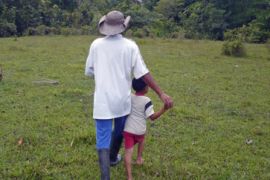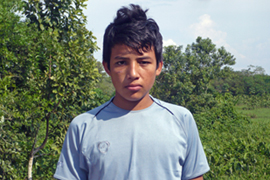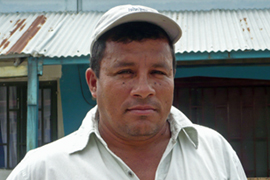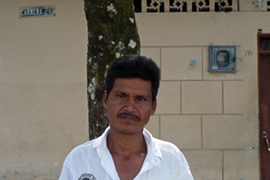Coca pickers’ lost livelihoods
Colombian peasants talk about the situation for coca farmers in the country’s south.

The US and Colombian governments’ war on the cocaine industry has left many peasants in the Latin American nation without a livelihood. Alternatives to coca – the primary crop used to make cocaine – are lacking.
Peasants involved in the industry told Al Jazeera about their work, their concerns and how coca arrived in Colombia.
|
Edward Saul Thomas, 14, from El Benado village, Putumayo |
I started working in coca production at 10 years old.
 |
I work on my family’s farm and I go to other farms and work there. It’s is not too hard, I really enjoy it. I live with my cousin’s family. My family farm is three hectares.
It’s better to pick coca and make base than pick bananas because with the coca you always know where you are going to sell it, but with the bananas you don’t know if you will sell it or not.
One week per month I work eight hour day picking and helping to make coca base. In the best times we got 120,000 pesos [$52] in a week but I had to use it to pay for school and clothes.
Now there are no jobs or food. I do domestic jobs now. Anything.
I quit school because I did not have enough money to pay for it. I have missed the last two years.
I think that the plantations should be legal, then there would be no problem to sell coca and to live.
That way we can afford schools, clothes, food and everyone will be happy.
I don’t care too much about the people in other countries doing cocaine. The people abroad are only our clients. There is no other relation to them. It is a market business. We have the shit here and they enjoy it.
I have seen the cocaine and been invited to snort it but I didn’t want it because I thought I would get addicted.
I know more than 20 children who work in cocaine production, and one or two who have taken it.”
|
Fernando Hio, 16, from Pariso village, Putumayo |
Many people in this area have left and there are many abandoned houses. I used to live with my family in the village but now I live in town and my family lives in the village.
I go to school. I have four brothers and my parents but they are separated. I work in different jobs around town and in farming.
I have planted and picked coca leaves and made coca base. It is part of my family’s business. We have a two hectare farm. We can pick 120 kilos of coca leaves in a day when in season. We make about 700 grams per day from those leaves.
We do this each season, about every two months. We did the process 15 days ago and picked about 95 kilos, making around 600 to 700 grams of base – sometimes we get different amounts of base from the leaves.
I have been working in the coca industry for eight years.
My grandparents are from Putumayo and we have grown coca since they started doing it. I like working there because we make good money. It is hard work, we work about eight hours a day, depending on how much there is to do. I might go home for about eight days to help pick the crop and make base each season.
The process of making base takes three days. We start at 7am and work until 4pm picking leaves. After 4 or 5pm we start making the base.
We put all of the coca leaves onto a wooden floor and chop them up. We spread cement on top of the leaves and mix it like a salad. We put the leaves in a big bucket with gasoline and mix it.
Afterwards we drain the gasoline into another bucket and throw the leaves away. We add baking soda and we mix this with water and uric acid. We then use the baking soda to separate the gasoline and the cocaine.
Everyone takes money from the business. I get about 20,000 peso per week worked. My family keeps something for food. I spend it with my girlfriend.
Many farms have been affected by the eradication scheme and after the fumigation they don’t make the same money so they are looking for new sources of money.
Some of my brothers are looking for new land to plant cocaine. Our land is useless right now as it has been fumigated.
The fumigations have contaminated our water which we use for the animals and our legal crops – bananas and pineapples – have been contaminated also. We can’t live on the land at the moment.
My brothers are 28 and 23. My other brothers are trying to find jobs in agriculture and working in town.
I want to continue to work in cocaine production – there is nothing else. I am worried because there is no more money.
If I could do anything I would go to university and maybe take a degree in chemistry or business administration.
I don’t really know anything about the government, but I think they should give us some kind of help – education or money – for the people.
The young people here don’t use drugs – some but really a few.
I don’t pay attention to the consumption side. I don’t see the link between growing it and taking it elsewhere in the world. We know that it is illegal because we hear the propaganda about it. We feel guilty because of that but that’s it.
What we know is that we have to suffer here. Our part is always the hard one. The hard work and the hard part are always here. The nice part is always away from here [in the consumption].”
|
Cecilia Anaya, 68, president of the peasants organisation Anuc in the municipality of Puerto Asis in Putumayo |
We feel that we are much worse off today than five or six years ago. Many people have been displaced and are coming to the commercial area and leaving the rural land empty.
As peasants’ leaders we believe the problem is social and that the government is not willing to recognise this.
Society offers us a lack of opportunities. We want to work. We want to go back to the land and we want economic alternatives from the government.
We don’t want to receive anything for free. We just want to work in good conditions.
|
Guillermo Leon Taborda, 58, former coca picker, from Puerto Asis |
I came from Cali in 1978 to find a job and received land from my brother. A guy came and told me that growing coca on the land was best, so I did.
The government doesn’t have any programme to solve the problems for the peasants. For example, the ‘Families Action’ programme by the government gives a small amount of money for food, nutrition and basic needs. It’s 24,000 pesos every two months.
People who come to the city in order to receive it have to spend 10,000 to get to the city in the first place.
There’s perhaps 5,000 farms in Putumayo picking and producing coca but after the fumigations, eradication, it’s hard to make money.
Pre-2000 the guerrillas were only involved in regulating the trade of cocaine with the mafia. Post-2000 they have become more involved in the production. So the mafia has lost out which has led to fighting between the groups.
The mafia are with the paramilitary groups. Guerrillas fight not for belief but for the market.
Then the paramilitaries start killing many more people in Putumayo – the peasants, farmers and this had the support of the army because the guerrillas are being targeted.
|
Luis Eduardo Montenegro, 42, vice-president of the peasants organisation Anuc, for the department of Putumayo, from Puerto Asis |
Many people came here in the 1970s to find a piece of empty land without an owner, to subside on, after being displaced by landowners elsewhere.
 |
They did that by themselves without government help because Putumayo was a land forgotten by the state.
The only opportunity in the Putumayo area was oil or petroleum exploration so many people came here to try and get opportunities for jobs in oil in the town, Puerto Asis.
As there were actually not many jobs at that time many people had to find other ways to subside here. So they tried planting rice, corn, cotton.
At that moment the peasants brought goods to Puerto Asis, it was full of goods, but there was no one to buy them as there was too much for Puerto Asis and there was not the infrastructure to take it to sell it elsewhere.
At that moment it was very frustrating for the peasants as they couldn’t do anything to improve roads and communications, and the goods were lost and destroyed in town.
In 1975, people started knowing about coca plantations and the first crop was grown here. People from other cities came here and showed them how to make money from producing coca.
I was a kid. For the peasants, after the frustration with the other fruits, they received the rumour that there was a new plant that would give them money, but that it was like any other seed.
The first seeds of coca crops came from Peru and it wasn’t hard to find it given from peasants to peasants so it spread around easily.
The plant takes only six months to give leaves so was very fast for them. People in Peru and in the centre of Colombia [Medellin and Cali] came here to buy the leaves. So they would sell the leaves to them – not to people from here because they wouldn’t know what to do with them, what they were for.
You could make a good wage – 200,000 pesos [now $86] a month. It was really good, it was the amount you could make in six months from selling corn or rice. The money changed life completely for the peasants.
But the peasants lacked education and culture and they spent their increased income on alcohol, women, motorbikes – they wasted the money.
Many people started to come from other areas of Colombia to here because it was the “new gold”.
In the 70s many people came here not just to work in coca production but also to offer services – girls, for instance – or earn off the economy here.
People were aware that growing coca was illegal but the government didn’t chase anyone so it was part of the culture and a free market here. It wasn’t relevant that it was illegal, people just got on with it and the government closed their eyes.
The government started to realise the dimension of the problem in the very late 80s because after those 15 years the mafia had consolidated power and fighting started between the cartels.
Then in the late 1980s and early 1990s the production in Putumayo was an estimated 40 tonnes a month of produced cocaine. The cartels form Cali and Medellin who had come started cocaine labs here by then. They controlled everything by then and that was the peak.
Then because of the fight between the cartels and competition between them many people who had come here to work were being recruited as killers – so a new part of the process started which was the paramilitary groups created by the cartels.
My father had a farm when I was 12. He was frustrated by growing bananas and rice. I am the eldest of eight children. My father brought in some new [coca] seeds one day and said that it was the “only way to survive”. So we planted them.
We were a bit aware that it was illicit but everyone was planting them so it seemed the best choice.
The first thing they did with the money we made was to make a proper house, buy clothes for us children and get proper tools for the land. We had a 100 hectare farm – it was empty land to start with, so we just fenced it off and took it.
My family is Christian and we were conscious that the plant would bring problems in the future. Our parents taught us as children that we would have to stop planting coca one day, and that’s why we are alive today.
Others did not stop and got more and more involved and ended up getting killed. In the beginning my father’s dream was to have a cattle farm but because of the frustration in achieving this we planted and picked the coca leaves and found out how to make it into coca base. Once we learnt how to do it, we did it ourselves.
In the 90s my parents quit coca production because they said it had become too dangerous. At that moment we produced one and a half tonnes from the farm every three months.
In the region there were 200 families and each produced three kilos of base in one season. The region was Da Nuevo. Now barely 10 per cent of that is produced.
I estimate that in Putumayo today five dozen families are living from the crop, making maybe 200 kilos per month base.
The UN said this year that the plantations are coming back to this area. Some people are now eradicating while some are planting.
The policy of eradication and fumigation started to be carried out in 2000. So by 2004 the fumigation and eradication had finished 80 per cent to 90 per cent of production in Putumayo.
We are asking for alternatives and basic needs – for example, the state gives peasants a term of three years to substitute the coca plants left for legal plantations but of course that needs subsidising.
We don’t want anything special or a big deal. Only a way to survive by ourselves. For example integral farms – fish, cows, pork. A security plan for food. At the same time we believe we should be able to prepare the kids to look after the farm – therefore we need education.
In the end we want land and a farm we can survive from and for the that Putumayo needs roads and communication systems. I believe alternatives are possible because the plantations processing coca came with fumigations, the army, violence and conflict. For the peasants this is not a way to live.
We would rather not be rich but have the security needed and the opportunity to have a good life. We will do everything to have a decent life.
We want people of the world to understand that the piece of land that is Putumayo and the Amazon has people living inside it. We are happy to take care of the natural resources here but we feel it is fair to have compensation form the first world for the life we have here.
For us we are aware that what we are doing affects people who are addicted. But the addicts are us are victims of the same problem.
The difference is that for the peasants there is no choice. We do it just to survive. So we don’t agree when Uribe says the peasants are terrorists, just because we are trying to survive on this land without alternatives.
The children are affected because the only thing they know so far is the coca plantation. So they start to believe it is they only way to make money here. So that’s how they are affected. They don’t see any alternatives.”
|
Simon Burbano, 44, head of family of eight children, from the village of El Aguila, Putumayo |
All of my children go to school and help the family in domestic issues. They work on the land. There are eight families in the area. We cut grass for the cows to eat, cut wood and grow coca on the 20 hectares we have.
 |
We have no outside help or staff. The male kids start working from seven-years-old. The girls work indoors but all of the family works.
We’re originally from the Putumayo region. At present we’re growing about half a hectare of coca. The last four years have been really bad for coca plantations so we are not keeping too much. Because of the pressure of the eradication and the decrease in price.
We have been affected by the fumigation. It has affected land because we made a loan from the bank to plant cocona – a fruit – and all the cocona was fumigated with the coca. So we lost it all and a five million peso loan.
We also lost eight cows because they drank water from the river which had chemicals in it. It depends on the rain. If there is no rain then the water keeps the poison in it.
When the fumigation starts you can hear the engines of the planes and helicopters. There are six helicopters protecting the planes and six small planes doing the fumigation. We start to feel afraid not just because of the fumigation but because if they see you running they could think you are a guerrilla and kill you. So we just try to stay inside.
All production has decreased in Putumayo and most people have left the land. Most go to big cities to find work. Six years ago we used to have nearly a hectare coca plantation. It made 300,000 pesos [$130] in two months.
But I’m also a carpenter so people hired me for that. I made houses for coca producers and the town made money then so as a carpenter I could make 600,000 pesos [$160] per week.
Now there is no job. We make 400,000 to 500,000 [$173 to $216] pesos per month today, a small amount from coca and partly from labouring. There’s no government help.
We are afraid of the guerrillas now because they come to our house asking for the other groups and then vice versa. One of my brothers disappeared because of the people from the town [the paramilitaries].
Because I have seven girls I had to take them to the town for safety and now all the females and their mother live in town. We’re afraid of the paramilitaries and the guerrillas.
We want the government to implement strategies for people to buy the goods we produce here, for example, bananas, yucca. The other way the government can help is to create government positions.
The government programmes have benefited the people living in the town but not the peasants. Because peasants have to pay to get to the town and it doesn’t make sense.
|
Maria Delgado, 38, mother with five daughters, lives in El Benado village, Putumayo |
We have three hectares on our farm – two for farming and one for our home. We have been working with coca plants for a long time and now because of the bad market we are growing pineapples.
 |
We are the only ones working there. All of the family help to pick the coca leaves.
When the price was very good – more than five years ago – we made nearly one million pesos in two months. Our fields are now empty because of fumigation. Our last plantation was fumigated about 50 days ago. The helicopters and planes came and fumigated it.
We are making 10,000 pesos [$4.3] a week from the pineapples – it is not enough to survive. My husband has left the house and went to a place close by to try and pick coffee. He sends me about 50,000 pesos [$21.6] per month – it’s not much, so I sometimes have to do domestic work in town.
All of the children go to school. I have to pay 2000 pesos [$0.8] weekly for the kids for food at school.
My health has not been affected by the fumigations but the community does feel it because all of the people around our house who are growing crops have been affected.
We know the food is contaminated so we don’t eat it. People are starving now. There is no food to eat and no money to buy food. The people in town avoid eating local food because they know it is contaminated. But we can’t survive on pineapple anyway, so we are starving.
After all the fumigation the land is damaged a lot so now we’re trying to get together to plant our basic needs in terms of food. But the problem is that the land is in a bad shape after the fumigations.
They say now the people are suffering depression because there are no jobs, money, food – people are under stress.
The paramilitaries and the guerrillas have not directly affected us but I know that they often go past my house.”